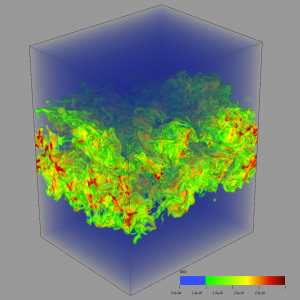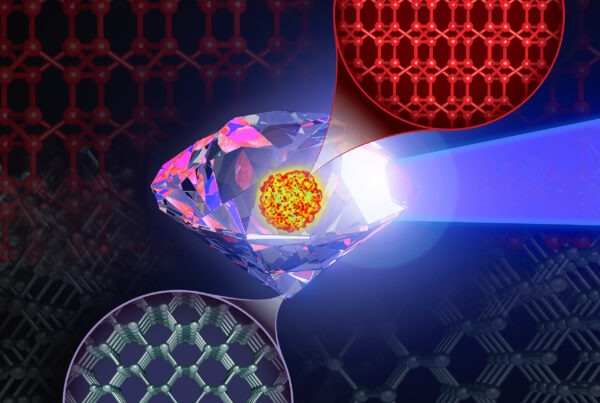In a farewell nod to Titan, scheduled to be decommissioned in August 2019, we present a short series of features highlighting some of Titan’s impactful contributions to scientific research.
The internal combustion engine has been around since the 19th century and remains the most affordable, reliable way to power the US transportation sector and provide electrical power on demand.
But 21st century engines are getting a boost from today’s top supercomputers. Through modeling and simulation, scientists and engineers can study how small-scale chemical reactions and turbulence affect performance. By understanding exactly when, where, and how fuel burns in the interior of an engine, researchers can improve engine designs and fuel blends to increase efficiency and reduce pollutant emissions.
Over the past 5 years, researchers led by Jacqueline Chen of Sandia National Laboratories modeled a range of combustion scenarios—including conditions relevant for gasoline and diesel engines and power turbines—on the Titan supercomputer at the Oak Ridge Leadership Computing Facility (OLCF), a US Department of Energy (DOE) Office of Science User Facility at DOE’s Oak Ridge National Laboratory.
A world-leading supercomputer in operation since 2012, the 27-petaflop Cray XK7 hybrid CPU-GPU system is being decommissioned in August, but its impact on combustion research and development and other scientific applications will continue for some time.
The Titan simulations are providing benchmarks that complement experiments for combustion model development and validation. The simulations focus on multiregime combustion in which flame propagation is affected by ignition processes that are sensitive to nuances of fuel chemistry across a broad range of temperatures and pressures.
“We need to understand the dynamics of turbulence-chemistry interactions to develop predictive computer models that engine designers can use,” Chen said. “With Titan, we’ve been able to increase the realism in the actual coupling between turbulent mixing and chemical kinetics associated with ignition for surrogate diesel and gasoline fuels.”
Chen’s team uses a direct numerical simulation (DNS) code called S3D to resolve the microscale physics of combustion on a 3D grid. The massively parallel S3D code enabled combustion simulations of increasing complexity on Titan’s predecessor, Jaguar, including a 2008 simulation of a hydrogen flame that was the first to fully resolve detailed chemical interactions in a turbulent flow environment.
On Titan, the team coupled S3D with Legion, a data-centric programming model for writing high-performance applications for distributed, heterogeneous architectures. S3D-Legion used Titan’s GPUs and allowed the team to push simulations into new regimes resembling the thermochemical conditions of advanced combustion engines that undergo multistage ignition (moving from low to high temperatures). The team was also able to simulate lean-burning dilute combustion that mixes less fuel with air diluted with exhaust gases to improve overall engine efficiency.
Two Titan studies
Cool flames
Accounting for over 20 percent of US petroleum consumption, primarily powering heavy trucks, ships, and industrial machines, diesel may be overlooked by millions of passenger car drivers. However, features of the diesel engine are critical to advanced combustion.
Whereas gasoline engines use spark ignition to trigger combustion, diesel engines use autoignition in which pistons compress the fuel-air mixture to high temperatures and pressures until the mixture self-combusts.
Compared with gasoline engines, diesel engines are more fuel-efficient and release fewer greenhouse gases. However, they release more nitrogen oxides and soot and typically come with a higher price tag.
In diesel combustion, lower-temperature “cool” flames (less than 1,000 degrees Kelvin, or 1,340 degrees Fahrenheit) ignite and burn, creating the environment for subsequent high-temperature ignition regions. This first stage of cool flame ignition begins in regions that are fuel lean where the ignition delay is minimal, and then moves into fuel-rich regions that are more difficult to ignite, creating the environment for a subsequent high-temperature ignition stage.
Researchers estimate that low-temperature combustion could improve diesel engine efficiency by 20 percent. Low-temperature combustion can also eliminate knock from gasoline engines and improve their efficiency.
But unlike spark ignition engines, autoignition in diesel engines is less controlled, and researchers need to understand the stages of the ignition process. The extreme environment inside an operating diesel engine also makes observing low-temperature combustion and multistage ignition difficult.
“We can’t resolve these cool flames with sufficient accuracy in physical experiments,” Chen said. “The cool flames are extraordinarily thin—that is, a few microns—and the spatial resolution of measurements that can be performed in operating engines is limited.”
A 2018 journal article authored by Giulio Borghesi of Sandia and coauthored by Chen describes how the team analyzed autoignition under highly turbulent diesel engine conditions requiring 3 billion grid cells at 3 micron resolution and 4 nanosecond time steps using n-dodecane as a surrogate for diesel fuel. Because diesel fuel itself is still too computationally complex to simulate in realistic conditions, researchers model n-dodecane, which combusts much like diesel. The 2018 study extended the findings of a 2D study on Titan in 2017 that used dimethyl ether as the surrogate fuel.

Hydrogen peroxide species undergoing two-stage autoignition in a temporally evolving air/n-dodecane jet. Image courtesy of Jacqueline Chen
Both the 2017 and 2018 simulations established that low-temperature combustion occurs first and then ignites high-temperature combustion through rapid chemical reactions and heat release coupled with molecular and turbulent transport. Surprisingly, the simulations showed that ignition occurs faster and in more fuel-rich regions than predicted from baseline simulations that do not include transport processes.
The discovery that ignition can happen more quickly in turbulent conditions was counterintuitive because the presence of turbulence usually inhibits ignition by dissipating heat and radical species away from developing ignition kernels. However, the simulations revealed that in stratified mixtures—those having both fuel-rich and fuel-lean regions—both laminar (or streamlined) cool flame propagation and turbulent transport processes aid in delivering heat and radical species from easier-to-ignite, fuel-lean mixtures to harder-to-ignite, fuel-rich mixtures, thereby accelerating overall ignition.
With a clearer picture of multistage autoignition, researchers can start to think about optimizing fuel stratification for both ignition timing and flame propagation rates, Chen said.
“There are a lot of knobs we have to control mixture formation,” Chen said. “For example, we can vary the turbulent mixing rates of fuel and oxidizer, the level of oxidant dilution, the ambient temperature, and fuel chemistry. Some combination of these parameters can be used to create a stratified mixture that is more or less reactive to control ignition timing and subsequent combustion and emissions rates.”
Turbulent turbines
On Titan in 2018, Chen’s team also took an unprecedented look at premixed stratified combustion in highly turbulent conditions like those found in gas turbines. Simpler in design and lighter in materials than piston-driven internal combustion engines, gas turbines are used in airplanes and industrial power generation. Many gas turbines burn lean to improve efficiency while minimizing harmful nitric oxide emissions.
Chen’s team collaborated with Evatt Hawkes and Haiou Wang from the University of New South Wales to simulate stratified premixed jet flames, with a central jet surrounded by a fuel-rich pilot flame, under intense turbulence.
The study is one of the few DNS studies of a turbulent stratified premixed flame and is the only one to focus on conditions with low reactivity and high turbulence intensity—a feature of lean turbulent flames that is rarely modeled because of its computational complexity.
Looking to the future, Chen’s team and Tarek Echekki from North Carolina State University will use Titan’s successor, the Summit IBM AC922 system, to incorporate machine learning into the S3D-Legion workflow using a method known as principal component analysis that will systematically reduce the composition space by identifying the most influential chemical, molecular, and turbulent quantities.
“By using artificial neural networks, we should be able to tabulate these quantities as part of a strategy to develop a reduced order surrogate DNS,” Chen said.
Reducing the number of chemical components that are transported in the DNS using machine learning will allow Chen’s team to focus its computational effort elsewhere and model more complicated engine geometries, intense turbulent features, or complex fuels.
“We’re moving up to much higher pressures and finer grid counts and pushing into more realistic regimes,” Chen said.
UT-Battelle LLC manages Oak Ridge National Laboratory for DOE’s Office of Science, the single largest supporter of basic research in the physical sciences in the United States. DOE’s Office of Science is working to address some of the most pressing challenges of our time. For more information, visit https://energy.gov/science.
Related publications:
G. Borghesi, A. Krisman, T. Lu, and J. H. Chen, “Direct Numerical Simulation of a Temporally Evolving Air/n-Dodecane Jet at Low-Temperature Diesel-Relevant Conditions.” Combustion and Flame 195 (2018), doi: 10.1016/j.combustflame.2018.02.020.
H. Wang, E. R. Hawkes, B. Savard, and J. H. Chen, “Direct Numerical Simulation of a High CH4/Air Stratified Premixed Jet Flame.” Combustion and Flame 193 (2018), doi: 10.1016/j.combustflame.2018.03.025.






